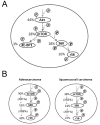Mammalian target of rapamycin: a central node of complex signaling cascades
- PMID: 21738819
- PMCID: PMC3127069
Mammalian target of rapamycin: a central node of complex signaling cascades
Abstract
The mammalian target of rapamycin (mTOR) is a serine/threonine kinase that regulates cell growth and metabolism in response to diverse external stimuli. In the presence of mitogenic stimuli, mTOR transduces signals that activate the translational machinery and promote cell growth. mTOR functions as a central node in a complex net of signaling pathways that are involved both in normal physiological, as well as pathogenic events. mTOR signaling occurs in concert with upstream Akt and tuberous sclerosis complex (TSC) and several downstream effectors. During the past few decades, the mTOR-mediated pathway has been shown to promote tumorigenesis through the coordinated phosphorylation of proteins that directly regulate cell-cycle progression and metabolism, as well as transcription factors that regulate the expression of genes involved in the oncogenic processes. The importance of mTOR signaling in oncology is now widely accepted, and agents that selectively target mTOR have been developed as anti-cancer drugs. In this review, we highlight the past research on mTOR, including clinical and pathological analyses, and describe its molecular mechanisms of signaling, and its roles in the physiology and pathology of human diseases, particularly, lung carcinomas. We also discuss strategies that might lead to more effective clinical treatments of several diseases by targeting mTOR.
Keywords: lung cancer; mTOR; molecular targeting therapy; rapamycin.
Figures







References
-
- Vignot S, Faivre S, Aguirre D, Raymond E. mTOR-targeted therapy of cancer with rapamycin derivatives. Ann Oncol. 2005;16:525–537. - PubMed
-
- Wullschleger S, Loewith R, Hall MN. TOR signaling in growth and metabolism. Cell. 2006;124:471–484. - PubMed
-
- Fingar DC, Blenis J. Target of rapamycin (TOR): an integrator of nutrient and growth factor signals and coordinator of cell growth and cell cycle progression. Oncogene. 2004;23:3151–3171. - PubMed
-
- Hay N, Sonenberg N. Upstream and downstream of mTOR. Genes Dev. 2004;18:1926–1945. - PubMed
Publication types
MeSH terms
Substances
LinkOut - more resources
Full Text Sources
Miscellaneous
